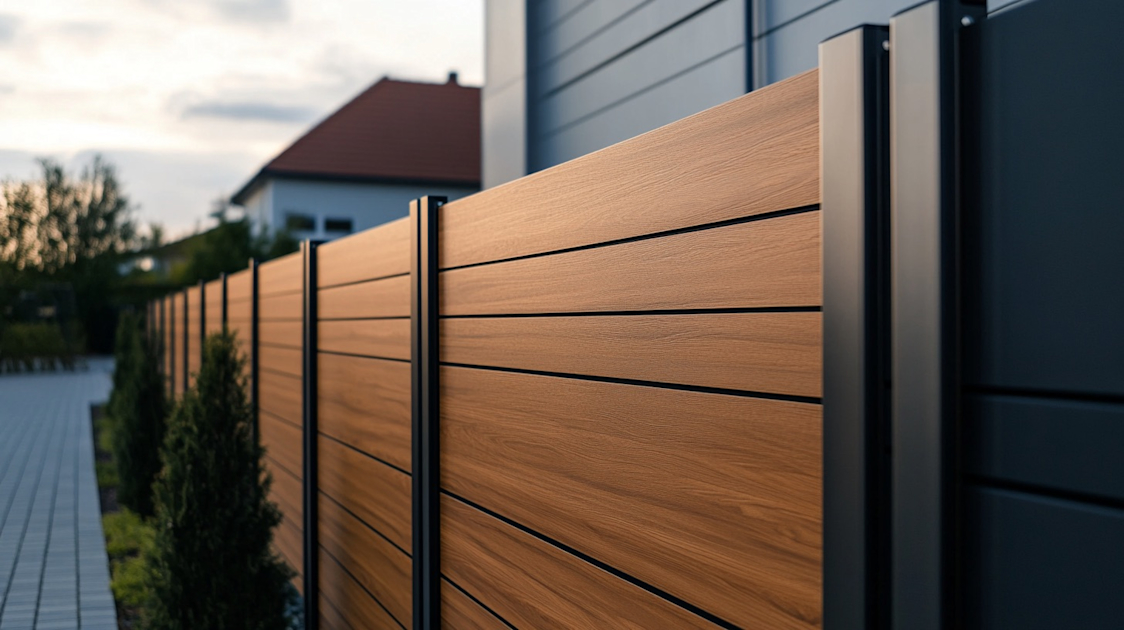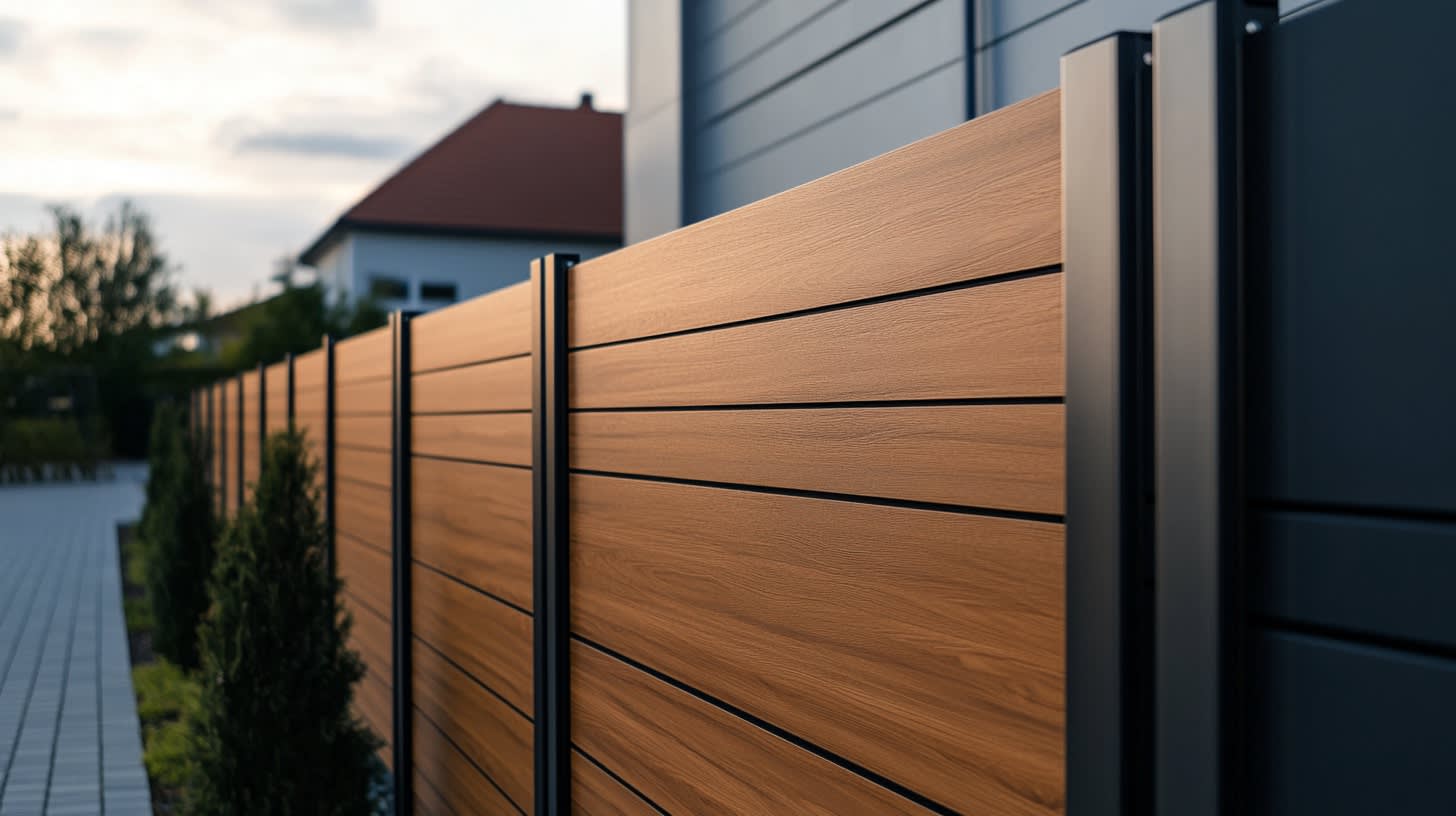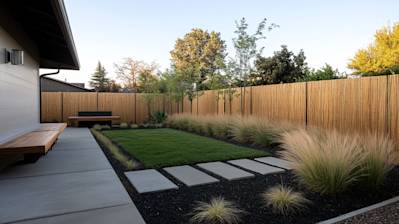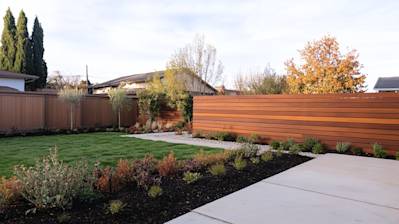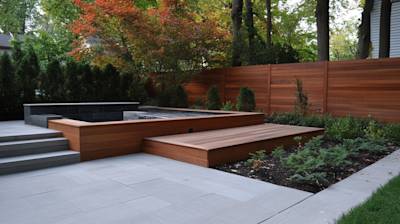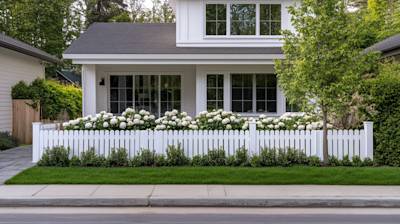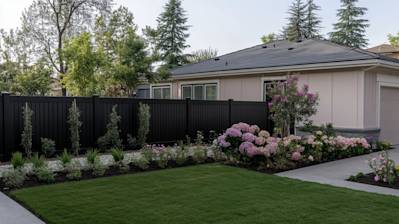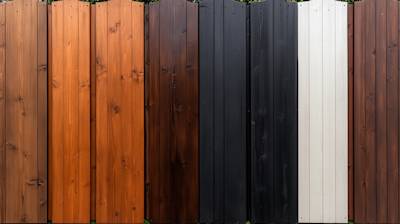Homeowners or commercial property owners looking to bolster security, enhance appearances, establish boundaries, and improve their property values, are increasingly opting for a wood and metal fence. It combines the classic elegance of wood and the robust durability of metal, making such fences visually appealing and long-lasting.
A Fusion of Traditions and Technology
Wood and metal fences interrelate aesthetics, stability, and up-to-date design. Iron, steel, or aluminum are used to provide the strength and framework, while wood adds charm and a natural feel to the structure.
- Wood: Weather-resistant types of wood like cedar, redwood, or pressure-treated pine are commonly used in these fences.
- Metal: Metals like iron, steel, or aluminum lend strength to the structure and are extremely resilient to weather conditions.
Understanding the Intricacies of a Wood and Metal Fence
Building a fence that brings together wood and metal involves sophisticated details and design considerations. Let's delve deeper to understand the nuances of constructing a wood and metal fence.
The Strength of Metal
Metal components usually form the structure or frame of the fence. Metals can withstand severe weather conditions, are resistant to pests, and require minimal maintenance over time.
Steel is sturdy and durable. However, it’s prone to rust if not properly treated. Aluminium and iron are alternatives that are rust-resistant and add a sleek, modern look to the fence.
The Appeal of Wood
Timber features on panels or pickets, including patterns and designs. This adds elegance and a naturalistic look to the fence, rendering a perfect balance of style and strength.
When considering wood, it's essential to choose a type that can stand up to outdoor weather conditions and resist decay. Cedar and redwood are naturally resistant to both decay and pests, while pressure-treated pine is a cost-effective yet durable option.
Keeping Up with the Maintenance
Maintaining your wood and metal fence is crucial to preserving its aesthetics and longevity. It's recommended to clean the fence at least once a year with a power washer or by hand using a long-handled brush.
- Wood maintenance: Wood can warp, rot, or become breeding grounds for pests. Applying a sealant or stain every 2-3 years can help protect the wood from these issues.
- Metal maintenance: To prevent metal components from rusting, regular inspection is crucial, and any areas showing signs of rust should be treated promptly.
Style and Design Options Galore
There's a wealth of design options when it comes to wood and metal fences. You could choose a horizontal plank design or go for a more traditional vertical style. You can also decide on the height of the fence, the spacing between the wood panels, and the pattern in which they're arranged.
Finding the Right Contractor for Your Wood and Metal Fence
Once you're ready to install your wood and metal fence, it's wise to seek professional help. Here are some factors to consider when choosing a contractor:
- Expertise and experience
- License and insurance
- Client reviews and ratings
A skilled contractor can guide you through the process and ensure your wood and metal fence is a valuable addition to your property.
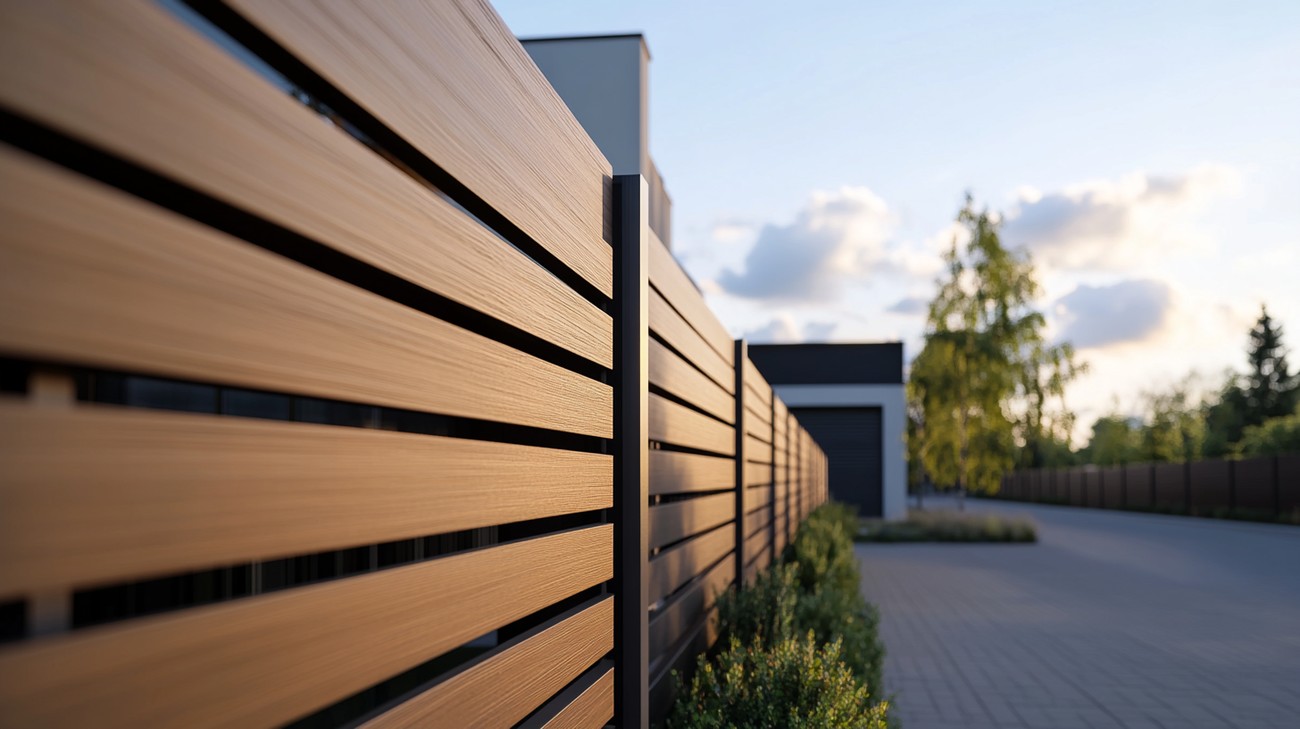
Frequently Asked Questions about Wood And Metal Fence
Are wood and metal fences durable?
Wood and metal fences are quite durable. Wood provides a classic and warm appearance, but it does require regular maintenance such as painting or staining to keep it looking its best and to protect it from environmental elements.
On the other hand, metal, particularly steel and aluminum, is incredibly sturdy and resistant to many environmental conditions. It won't warp or rot like wood can. Plus, many metal fences come with protective coatings to guard against rust.
How much does a wood and metal fence cost?
The cost of wood and metal fences can vary depending on the type of wood, the type of metal, the design of the fence, and labor costs. Generally, metal fences tend to be more expensive than wood fences because metal is costly to produce. However, because of their durability and low maintenance, metal fences can often be more cost-effective over the long term.
What wood types are commonly used for fences?
The most popular types of wood used in fences are pine, cedar, and redwood. Pine is the most affordable and easily accessible but it tends to rot faster. Cedar is more expensive but it's naturally resistant to decay, rot, and insect infestation. Redwood is the top-of-the-line option, it's the most resistant to environmental elements but also the most expensive.
What metal types are commonly used for fences?
The most common metals used for fencing are aluminum, steel, and wrought iron. Aluminum is lightweight, resistant to corrosion, and relatively affordable. Steel is more expensive but very strong and resilient. Wrought iron is the most expensive option, it offers unparalleled strength and a distinct, traditional aesthetic but requires regular maintenance to prevent rust.
How do I maintain a wood and metal fence?
Maintaining a wood and metal fence involves regular cleaning, painting, staining, or sealing for the wood parts, and preventing rust and scratches on the metal parts. It's also important to promptly address any damage like broken or loose parts to prevent further deterioration.
Will a wood and metal fence increase home value?
Well-maintained wood and metal fences can increase the aesthetic appeal of your home and thus, can add to its overall value. They offer increased privacy, enhanced security, and improved curb appeal — all of which are attractive to potential buyers.
How long does it take to install a wood and metal fence?
The time frame for installing a wood and metal fence can vary based on the complexity of the design, the size of the area to be fenced, and the specific conditions of your property. On average, professional contractors can install about 100 feet of fencing per day. DIY installations may take longer.
Can wood and metal fences be recycled?
Yes, most wood and metal materials used in fences can be recycled. Metals like aluminum, steel, and iron are highly recyclable and can be repurposed multiple times without losing their quality. Wood can be composed or reused in other woodwork projects. However, treated woods aren't typically recyclable due to their chemical content.
Pros of Wood and Metal Fence
Aesthetic Appeal
Wood
One of the most appealing aspects of a wood and metal fence, particularly the wooden part, is its aesthetic value. It is hard to beat the beauty of natural wood. Different varieties such as pine, cedar, cypress, and teak each offer unique colors, textures and grain patterns. This variety allows for customisation to fit individual preferences or to match the architectural style of a home or building.
Metal
Metal, on the other hand, provides a clean, sleek, and modern look that appeals to many homeowners. When combined, the wood and metal offer an attractive and unique contrast that can enhance the overall appearance of your property.
Strength and Durability
Wood
When properly treated and maintained, wood can last for several decades. Hardwood varieties, in particular, are known for their strength and resistance to wear, tear, and impact.
Metal
The metal part of the fence can be constructed from various materials such as steel, aluminum, or wrought iron, each offering a high degree of strength and durability. Metal is highly resistant to damage from insects, rot, and harsh weather conditions. The combination of wood and metal in a fence can therefore offer an ideal blend of beauty, strength, and longevity.
Flexibility
Wood
Wood offers flexibility in terms of design and installation. It can easily be cut and shaped into various sizes and designs. This allows for the creation of custom-made fences that fully meet the specific needs and preferences of different customers.
Metal
Metal, especially aluminum, is also highly versatile and can be shaped into different designs. Combining wood and metal in a fence gives you enormous flexibility to create a truly unique and personal touch to your landscape.
Cons of Wood and Metal Fence
Cost
One of the notable downsides of a wood and metal fence is its high cost. Both wood and metal materials can price significantly higher than other fence options such as vinyl and chain link. The labor costs for the installation services tend to be high as well given the skills needed to work both materials together.
Maintenance
Wood
While wood brings natural beauty, it also requires substantial maintenance to keep it in good condition. This includes regular staining or painting, sealing, and treatment for preventing rot and insect infestations. Without proper maintenance, wood can warp, crack, or rot significantly reducing the lifespan and appeal of the fence.
Metal
Similarly, metal parts also require maintenance such as regular cleaning and occasional painting to prevent rust, especially in the case of iron and certain types of steel. Aluminum fences, however, are relatively maintenance-free apart from occasional cleaning.
Installation Challenges
The installation process for a wood and metal fence can be complex and time-consuming. The process requires special craftsmanship to meld together two distinctly different materials, and can be tricky even for experienced fence installers. This is one reason why the labor cost for installing wood and metal fences tends to be higher than for other fence types.
Environmental Impacts
Wood
Although wood is a renewable resource, irresponsible logging practices can lead to deforestation and biodiversity loss. Besides, chemical treatments for increasing wood's durability might have adverse effects on the environment.
Metal
Metals like steel and iron have a high carbon footprint due to the processes used in their production, which involve the emission of greenhouse gases. Aluminum, while recyclable, requires a significant amount of energy for its production.
Myths and Misconceptions about Wood and Metal Fences
Few things are as quintessential to a homely American landscape as a robust, elegant fence. Two main materials dominate the world of residential fencing: wood, with its rustic charm, and metal, with its longevity and sleek modern aesthetic. Nevertheless, lots of misunderstandings revolve around these two popular fence options. We're going to tackle some of the most persistent and pervasive myths and legends about wood and metal fences.
Myth about Wood Fences
Myth 1: Wood Fences Do Not Last Long
While it is true that wood is not as inherently durable as metal, it is wrong to assume that wood fences deteriorate swiftly. A lot of factors contribute to the longevity of a wood fence including the type of timber used, the quality of construction, maintenance routines, and environmental conditions. If properly installed and well-maintained, certain hardwood fences can last up to 20 years.
Myth 2: Wood Fences Are High Maintenance
This misconception mostly comes from the fact that wood is a natural material that can suffer from rot, pests, and weathering – issues that metal fences do not have to deal with. However, modern treatments and finishes have made wooden fences more resistant to these problems, extending their lifespan and reducing maintenance efforts.
Myth 3: All Wood Fences Look Alike
Wood, as a material, is incredibly versatile. It can be painted, stained, and shaped to create a variety of styles, from rustic to contemporary. The kind of timber used (for instance, pine, cedar, or redwood) will also impact the overall look and feel. So, no, wooden fences do not have to look monotonous or all the same.
Myth 4: Wood Fences are not Environmentally Friendly
Contrary to perception, wood fences have a smaller carbon footprint than their metal counterparts. While logging has led to deforestation, most wood for fencing comes from sustainable forestry practices. Wood fencing is biodegradable and doesn’t contribute to landfill waste in the way that discarded metal fences do.
Myths about Metal Fences
Myth 1: Metal Fences are Impersonal and Unattractive
While metal might not have the natural charm of wood, it is not without its beauty or versatile applications. Metal fences can come in a range of colors, styles, and finishes, suiting an array of property styles from ultra-modern to vintage. Moreover, metal fencing can mimic the look of classic rod-iron fences or can have detailed design work incorporated.
Myth 2: You Can’t Customize Metal Fences
This is utterly false. Today, metal fabricators have progressed far beyond the one-size-fits-all model. You can tailor metal fences to fit specific tastes and needs. Customizations can range from choosing between steel or aluminum, playing with different designs and styles, to picking the ideal color to complement your home.
Myth 3: Metal Fences Rust Easily
While metal fences can rust, this risk is significantly reduced in modern metal fences. Often, metal fences are made of galvanized steel or aluminum, which are resistant to rust. Some metal fences may even have a powder-coated finish for additional protection.
Myth 4: Metal Fences are Too Expensive
While metal fences can have a higher upfront cost compared to wood, their cost-effectiveness shines in the long run. Metal fences often require less maintenance, withstand weather changes better, and possess a higher overall life expectancy than wooden fences, saving homeowners substantial amounts in repair and replacement costs.
Myth 5: Metal Fences Attract Lightning
The belief that a metal fence will attract lightning can be frightening; however, it is largely an old wives' tale. While it's true that metal does conduct electricity, lightning does not necessarily seek out metal. It seeks the easiest path to the ground, which is typically the highest object in an area, regardless of the material.
By setting the record straight about these wooden and metal fence myths, homeowners can make more informed decisions when it's time to choose a fence for their property. Remember, every material has its pros and cons—it’s all about finding the balance that works best for individual preferences and needs.
Summary
Just as it name implies, a wood and metal fence is a type of barrier that blends the organic appeal of lumber with the industrial aesthetic of metal. Its hybrid design merges the warm, timeless look of wood with the modern, utilitarian appeal of metal. The result? Not only a fence that's eye-catching, but also one that can withstand elements better. With this option, you get to enjoy a unique, hybrid look with enhanced durability.
Now, a wood and metal fence is more than just a physical boundary but also a stylish statement piece for any property. It lends itself an intriguing visual mix that's flexible enough to suit every style – from rustic country to urban contemporary. And let's not forget the functionality aspect: it's generally simple to install, provides good security and privacy, and requires less maintenance which makes it a smart choice for any homeowner.
Embracing a wood and metal fence for your home is like getting the best of both worlds. You gain all the benefits from the individual materials, while mitigating their weaknesses. The result is a visually appealing, cost-effective, and durable solution that can withstand the elements and time. It's undoubtedly a fantastic option for those wanting to make a lasting, aesthetically-pleasing impression on their property.
About Ornamental Solutions
Ornamental Solutions, hailing from the vibrant city of Sacramento, CA, is much more than an everyday company. We're your neighborhood buddies who just happen to be experts in all things ornamental for your home or business. Launched several years ago, our company vision is simple: enhancing the beauty of Sacramento one space at a time. We specialize in creating and installing decorations, ranging from sculptures and miniatures to major installations, all reflecting the spirit and bohemian charm of Sacramento. We're just a bunch of creative junkies who put artsy spins on everyday objects. Welcome to our little corner on the web!

